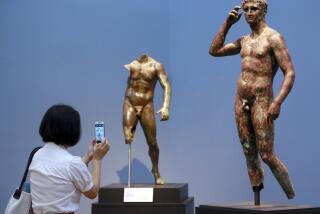The Getty Faces New Obstacle: Getty’s Son : Art: John Paul Getty II pledges $1.55 million to help keep Antonio Canova’s sculpture ‘Three Graces’ in Britain. It’s the second time he has helped prevent his father’s museum from enhancing its collection.
- Share via
In a surprise move, John Paul Getty II, son of the late American oil baron, has donated 1 million ($1.55 million) to prevent the Malibu museum his father founded from buying Antonio Canova’s neo-classical sculpture “The Three Graces” for 7.6 million (about $11.8 million) and exporting it from Britain.
British National Heritage Secretary Stephen Dorrell said that the billionaire--who lives a reclusive life in London but has emerged in the last decade as Britain’s greatest private philanthropist--contacted him Thursday to pledge the money to a campaign to buy the sculpture for London’s Victoria and Albert Museum. Getty’s pledge leaves the museum about 800,000 ($1.24 million) short of its goal.
The donation marks the second time Getty has contributed a large sum to prevent the Getty Museum from enhancing its collection at the expense of Britain’s cultural heritage. Getty--who was often at loggerheads with his father--gave $530,000 in 1985 to the Manchester City Art Gallery to stop Duccio’s “Crucifixion” painting from being exported to California.
His pledge to the V&A; is only the latest in a series of setbacks in the Getty Museum’s five-year effort to purchase Canova’s 19th-Century marble sculpture of three female nudes, however. The museum in 1989 agreed to buy the artwork from Fine Art Investment and Display Ltd., a Cayman Islands company that had purchased it in 1984 from its longtime owner, the Marquess of Tavistock.
But the Getty Museum’s export license has been repeatedly delayed while the V&A; has conducted an on-again, off-again fund-raising drive to match the Getty’s price and buy the sculpture for its collection.
In February the British Department of National Heritage deferred the Getty’s export license until Aug. 5, but on Tuesday Secretary Dorrell extended the deferral for three more months, to Nov. 5.
V&A; Director Elizabeth Esteve-Coll hailed the donation as “an act of outstanding generosity by a noted supporter of the arts.” In a statement released to the press, she said: “It gives huge impetus to the campaign, and will hearten all those who wish to see this marvelous work retained in this country.”
The Getty Museum’s administrative offices were closed Friday and museum director John Walsh could not be reached for comment on the latest Canova upset. On Tuesday, when the three-month export license deferral was announced, Walsh expressed disappointment and a loss of faith in the British export license system.
The sculpture was commissioned in 1814 by John Russell, 6th Duke of Bedford and installed in the Temple of the Graces at Woburn Abbey in Bedfordshire. Earlier this week Walsh said that the artwork is one of the greatest sculptures in private hands and that it sums up neo-classical ideals of beauty and harmony.
The third of the oil tycoon’s five sons, John Paul Getty II has acquired a fortune from a family trust but has lived an intensely troubled life. He lost his second wife, Talitha, in 1971, to a heroin overdose and nearly destroyed himself with drugs. But during the last decade he has made a comeback and emerged as a major philanthropist. His largest donation to date is $63 million, given in 1985 to the National Gallery in London.
More to Read
The biggest entertainment stories
Get our big stories about Hollywood, film, television, music, arts, culture and more right in your inbox as soon as they publish.
You may occasionally receive promotional content from the Los Angeles Times.










